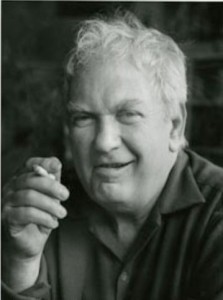By Emily Dunnack for Your Public Media
July 22nd is the birthday of Alexander Calder, one of the best-known and most prolific sculptors of the 20th century. His work hangs in museums all over the world, but for over 40 years, he lived and worked in Roxbury, a small town in Connecticut’s Litchfield Hills.

Alexander Calder, Artist, Roxbury, Connecticut. Photograph by Rosalie Thorne McKenna, 1958. 2011.344.1041. McKenna was known for her portraits of famous artists and writers – Connecticut Historical Society, ©The Rosalie Thorne McKenna Foundation
Calder was born into a family of artists in Lawnton, Pennsylvania, in 1898. His father and grandfather were both sculptors and his mother was a painter. He studied mechanical engineering in college and his engineering training served him well throughout his career, even though he became a professional artist in his 20s. He is best known for his mobiles, kinetic sculptures made up of geometric shapes and colors. These mobiles are works of engineering as well as art, perfectly balanced to gently twist and turn with the currents in the air.
Calder and his wife Louisa James moved to Connecticut in 1933. They purchased an old farmhouse in Roxbury, painted the main house flat black, and converted the old ice house into a studio where Calder created his art. Soon after Calder moved to Roxbury, Chick Austin, the legendary director of the Wadsworth Atheneum, began exhibiting and purchasing his work. Calder became an integral part of Austin’s circle, designing stage sets for a theatrical production and costumes for the Paper Ball, an elaborate costume party.
Calder also created prints; jewelry; wooden and wire sculptures (which he termed “constellations”); and large stationary sculptures (called “stabiles”). One of Calder’s largest stabiles is among Hartford’s most recognizable landmarks. Stegosaurus stands 50 feet high and is made of orange-coated steel plates constructed in Waterbury. It is the centerpiece of the Alfred E. Burr Memorial Mall, a small park adjacent to Hartford City Hall and the Wadsworth Atheneum Museum of Art in downtown Hartford.
Alexander Calder died in New York City on November 11, 1976, and is buried in Roxbury.
Emily Dunnack is the Head of Education Programs at the Connecticut Historical Society.
© Connecticut Public Broadcasting Network and Connecticut Historical Society. All rights reserved. This article originally appeared on Your Public Media
Note: ConnecticutHistory.org does not edit content originally published on another platform and therefore does not update any instances of outdated content or language.








